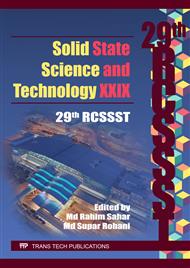p.352
p.358
p.365
p.370
p.374
p.379
p.387
p.393
p.401
Physical and Mechanical Characteristics of Porous SS316L for Biomedical Implant
Abstract:
Porous materials with open and interconnected pores are very interesting for biomedical applications as it provides a good base for the formation of bone ingrowth naturally. Besides, it also allows for body fluid transportation through the interconnected network. Therefore, in this work, foam replication method has been used to produce porous SS316L. The SS316L slurries were prepared by ball milling and mechanical stirring method. The polyurethane (PU) foam has been used as a sacrificial template. Sintering process was carried in a high vacuum furnace at 1200°C, 1250°C and 1300°C. The overall results show that increasing the sintering temperature from 1200°C to 1300°C and the using of different slurry mixing methods did not significantly affect the physical and mechanical properties of the porous SS316L produced. The density, porosity percentage and compression strength found for this porous SS316L were in the range of 1.35g/cm3-3g/cm3, 62% - 83%, and 30.6MPa-79MPa respectively. The SEM images also show that the microstructure of this porous SS316L mostly consisted of open and interconnected pores. Therefore, these results are very promising for biomedical implant application.
Info:
Periodical:
Pages:
374-378
Citation:
Online since:
October 2017
Authors:
Price:
Сopyright:
© 2017 Trans Tech Publications Ltd. All Rights Reserved
Share:
Citation:


